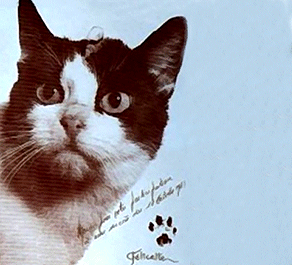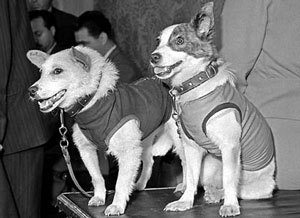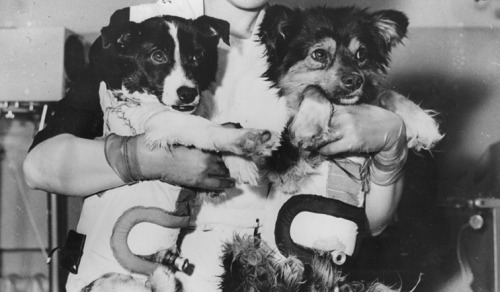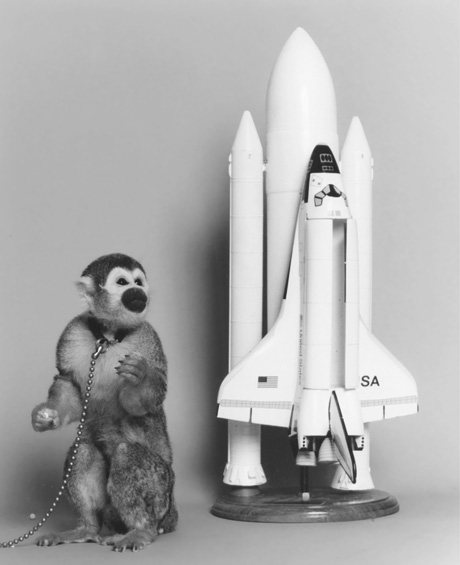Animal Sacrifice in the 20th and 21st Century
 |
| Laika, the most famous animal Astronaut via: <https://timedotcom.files.wordpress.com/2014/11/laika.jpeg?quality=65&strip=color&w=1100> |
Space is infinitely vast, yes. Space has had an influence on art, media and design, yes. But what really intrigued me this week was not those facts or 'Powers of Ten' (I rewatched this for the Nanotech + Art unit, as I found it just as fitting there as well) but rather in learning how countless animals were used, often with no intent for their safe return, in the space industry to test the safety of their space exploration equipment. Professor Vesna highlighted one very important and well known astronautical pooch, Laika, and her story, and I was then inspired to look into some lesser known animals that also went to space to help progress mankind's understanding of space exploration technologies. [1]
Here are some notable animal space pioneers:
 |
| Dezik and Tsygan, the first living space travelers. via: <http://todocaninos.com/wp-content/uploads/2014/07/DezikyTsygan.jpg> |
 |
| Felicette sporting her brain electrode in this signed glamour shot; her autograph is unverified for authenticity. via: <http://sixtiescity.net/Space/Felicette.gif> |
 |
| This time they made custom space vests, so Belka and Strelka have a quite official looking photo via: <http://www.dogingtonpost.com/wp-content/uploads/2012/08/belkastrelka.jpg> |
 |
| These dogs had a proper space exploration; 22 whole days in orbit. <http://24.media.tumblr.com/tumblr_lj80frpCoZ1qiwh6to1_500.jpg?__SQUARESPACE_CACHEVERSION=1329920596441> |
 |
| Gordo here, optimistically staring far off into the distance <http://cabinetmagazine.org/issues/34/c12-3_FINAL.jpg> |
 |
| Testing Ham's safely equipment (they finally figured out those parachutes) via: <http://i.ytimg.com/vi/FyjDJIH4zXM/hqdefault.jpg> |
Not all of these animals died, but many more were killed than named here. After reading Ham's story, I realized some were never even named. But all of them suffered the unusual circumstances of going into space on experimental technology. Not by choice or for personal glory, as human astronauts have, but they were sent unknowingly as a sacrifice for mankind. Though most cultures of the world have stopped using animal sacrifices to appease the angry gods of ancient times, we still offer these animals for the glory of a new deity, technology.
References ::
[1] Vesna, Victoria, narr. “8 Space pt 3” N.p., . web. 5 Nov 2012.
[2] "Russian Space Dogs." Russian Space Dogs. Web. 31 May 2015.
[3] "First Monkey in Space." Universe Today. 31 Aug. 2009. Web. 31 May 2015.
[4] "Purr-n-Fur UK | Felicette the Space Cat, and the Mythical Felix." Purr-n-Fur UK | Felicette the Space Cat, and the Mythical Felix. Web. 31 May 2015.
[5] "Belka & Strelka: The First Dogs in Space - The Dogington Post." The Dogington Post. 25 Aug. 2014. Web. 3 June 2015.
[6] "Veterok and Ugolyok." Zoom Room Dog Training RSS. Web. 3 June 2015.
[7] Burgess, Colin, and Chris Dubbs. Animals in Space: From Research Rockets to the Space Shuttle. Print.
[8] Haraway, Donna. Primate Visions: Gender, Race, and Nature in the World of Modern Science (New York: Routledge, 1989).

Animal sacrificing for scientific purposes you introduced is a profound topic and requires a debate in scientific society.
ReplyDeleteHi David,
ReplyDeleteI appreciate that you recognize the sacrifices of animals in your post. I am on the side however that argues that animal testing is absolutely necessary in order for scientists to understand the potential outcomes of an experiment on larger, more complex organisms aka humans. Also, I would say that the astronauts are not just risking their lives for "personal glory" as you put it, they are doing so for the advancement of human knowledge. We cannot give up animal testing without damaging the scientific process and exposing humans to higher levels of risk.
Hey Justin, I'm not really taking a side for or against animal testing. I am merely drawing a parallel between animal sacrifices for spiritual progress, and animal sacrifices for technological progress. As for "personal glory" that is but a mere fraction of their total intention that animals definitely do not share with their human travelers, (for example, money/compensation is also another thing they do not do it for).
ReplyDeleteI like your analogy to sacrificing animals for religious reasons, although the big difference in sacrificing animals for science (or our other big sacrifice, for food) is that it actually has some benefits. However I believe animals are often abused in the name of science or food and there are insufficient reasons for justifying it. I can't really say if this is such a case just from your blog, but I know it happens all the time and wouldn't be surprised to find that many of these tests were unnecessary.
ReplyDelete